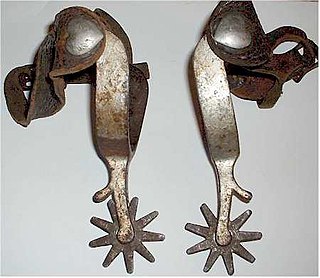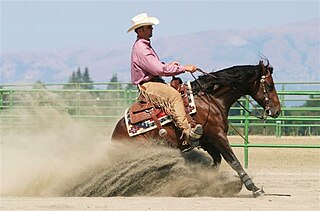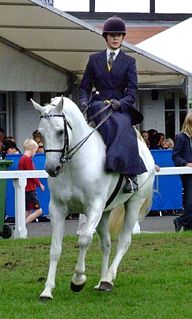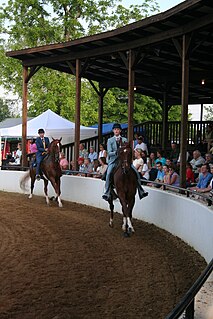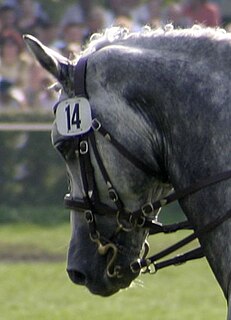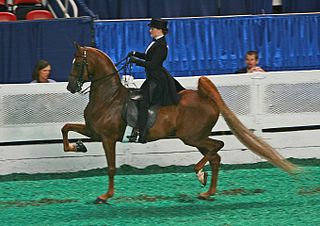This article needs additional citations for verification .(July 2011) (Learn how and when to remove this template message) |


Horses are ridden and driven in actual parades in many different ways. However, a Parade horse refers specifically to a type of horse attired in elaborate, specialized equipment that is more often seen today in specialized competitions and exhibitions than in parades.

A parade is a procession of people, usually organized along a street, often in costume, and often accompanied by marching bands, floats, or sometimes large balloons. Parades are held for a wide range of reasons, but are usually celebrations of some kind. In British English, the term 'parade' is usually reserved for either military parades or other occasions where participants march in formation; for celebratory occasions, the word procession is more usual. In the Canadian Forces, the term also has several less formal connotations.
Tack is equipment or accessories equipped on horses and other equines in the course of their use as domesticated animals. Saddles, stirrups, bridles, halters, reins, bits, harnesses, martingales, and breastplates are all forms of horse tack. Equipping a horse is often referred to as tacking up. A room to store such equipment, usually near or in a stable, is a tack room.
The "Parade horse" class is a form of competition seen at horse shows and festivals in the United States and Canada where the horse is attired in elaborate forms of western-style equipment, adorned heavily with silver, and the rider is dressed in brightly colored, elaborately decorated western wear. The hooves of the horse are often covered in sequins and brightly colored ribbons may be added to the mane and tail.

A horse show is a judged exhibition of horses and ponies. Many different horse breeds and equestrian disciplines hold competitions worldwide, from local to the international levels. Most horse shows run from one to three days, sometimes longer for major, all-breed events or national and international championships in a given discipline or breed. Most shows consist of a series of different performances, called classes, wherein a group of horses with similar training or characteristics compete against one another for awards and, often, prize money.

The United States of America (USA), commonly known as the United States or America, is a country comprising 50 states, a federal district, five major self-governing territories, and various possessions. At 3.8 million square miles, the United States is the world's third or fourth largest country by total area and is slightly smaller than the entire continent of Europe. With a population of over 327 million people, the U.S. is the third most populous country. The capital is Washington, D.C., and the most populous city is New York City. Most of the country is located contiguously in North America between Canada and Mexico.

Canada is a country in the northern part of North America. Its ten provinces and three territories extend from the Atlantic to the Pacific and northward into the Arctic Ocean, covering 9.98 million square kilometres, making it the world's second-largest country by total area. Its southern border with the United States, stretching some 8,891 kilometres (5,525 mi), is the world's longest bi-national land border. Canada's capital is Ottawa, and its three largest metropolitan areas are Toronto, Montreal, and Vancouver.
Horses are shown at a walk and a type of slow trot called a "Parade gait." High-stepping gaits and good manners are emphasized.
The equipment worn by the horse includes a western saddle, usually of black leather, that has extensive silver decoration, exaggerated features such as long tapaderos on the stirrups, flank trappings, with a heavily decorated breast collar added to the front. The bridle is also heavily decorated with silver, and, unlike most western-style bridles, has a noseband.

Western saddles are used for western riding and are the saddles used on working horses on cattle ranches throughout the United States, particularly in the west. They are the "cowboy" saddles familiar to movie viewers, rodeo fans, and those who have gone on trail rides at guest ranches. This saddle was designed to provide security and comfort to the rider when spending long hours on a horse, traveling over rugged terrain.
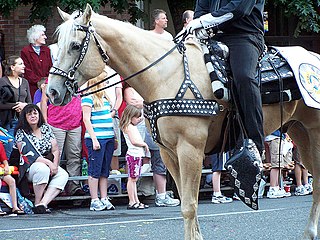
A tapadero, sometimes referred to as a "hooded stirrup," is leather cover over the front of a stirrup on a saddle that closes each stirrup from the front. A tapadero prevents the rider's boot from slipping through and also prevents brush encountered while working cattle on the open range from poking through the stirrup, injuring or impeding the horse or rider. Some designs can also provide protection in cold weather. They are also frequently used with young riders, as many parents and riding instructors feel they are a safety precaution. Most commonly seen today on a western saddle, particularly certain types of children's saddles and parade horse saddles, the tapadero is not common in modern times and is not allowed in most show competition other than Parade Horse competition and children's leadline.
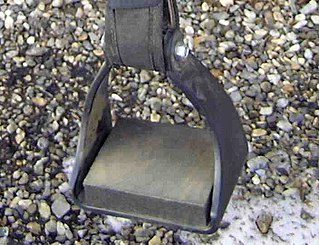
A stirrup is a light frame or ring that holds the foot of a rider, attached to the saddle by a strap, often called a stirrup leather. Stirrups are usually paired and are used to aid in mounting and as a support while using a riding animal. They greatly increase the rider's ability to stay in the saddle and control the mount, increasing the animal's usefulness to humans in areas such as communication, transportation and warfare.

This type of competition is seen primarily in American Saddlebred and Morgan horse competition. However, this type of attire is occasionally still seen on horses ridden in real parades, particularly major events in the southwestern United States, where there is still a strong Spanish cultural tradition, such as the Tournament of Roses Parade. The Hawaiian culture also has a tradition of using elaborately decorated horses and riders in parades and festivals riders in this tradition are known as "Pāʻū riders". This tradition involves the decoration of the horse and rider in flowing garments and Leis and utilizes a great variety of flowers to decorate the animal and rider. The dominant color of the Pāʻū Rider is determined by which island they are from.

The American Saddlebred is a horse breed from the United States. This breed was referred to as the "Horse America Made". Descended from riding-type horses bred at the time of the American Revolution, the American Saddlebred includes the Narragansett Pacer, Canadian Pacer, Morgan and Thoroughbred among its ancestors. Developed into its modern type in Kentucky, it was once known as the "Kentucky Saddler", and used extensively as an officer's mount in the American Civil War. In 1891, a breed registry was formed in the United States. Throughout the 20th century, the breed's popularity continued to grow in the United States, and exports began to South Africa and Great Britain. Since the formation of the US registry, almost 250,000 American Saddlebreds have been registered, and can now be found in countries around the world, with separate breed registries established in Great Britain, Australia, continental Europe, and southern Africa.

The Morgan horse is one of the earliest horse breeds developed in the United States. Tracing back to the foundation sire Figure, later named Justin Morgan after his best-known owner, Morgans served many roles in 19th-century American history, being used as coach horses and for harness racing, as general riding animals, and as cavalry horses during the American Civil War on both sides of the conflict. Morgans have influenced other major American breeds, including but not limited to the American Quarter Horse, Tennessee Walking Horse and the Standardbred. During the 19th and 20th centuries, they were exported to other countries, including England, where a Morgan stallion influenced the breeding of the Hackney horse. In 1907, the US Department of Agriculture established the US Morgan Horse Farm near Middlebury, Vermont for the purpose of perpetuating and improving the Morgan breed; the farm was later transferred to the University of Vermont.The first breed registry was established in 1909, and since then many organizations in the US, Europe and Oceania have developed. There were estimated to be over 175,000 Morgan horses worldwide in 2005.
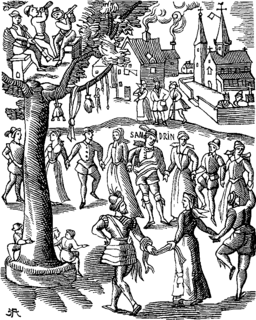
A festival is an event ordinarily celebrated by a community and centering on some characteristic aspect of that community and its religion or cultures. It is often marked as a local or national holiday, mela, or eid. Next to religion and folklore, a significant origin is agricultural. Food is such a vital resource that many festivals are associated with harvest time. Religious commemoration and thanksgiving for good harvests are blended in events that take place in autumn, such as Halloween in the northern hemisphere and Easter in the southern.

